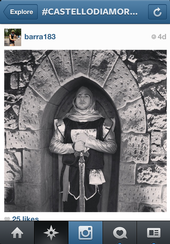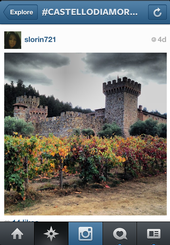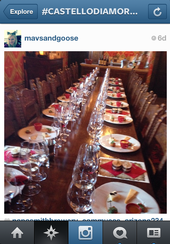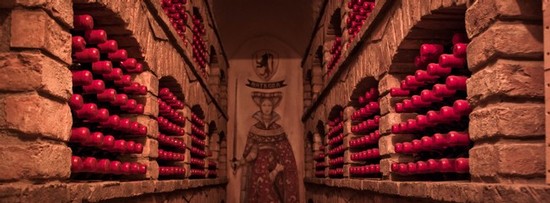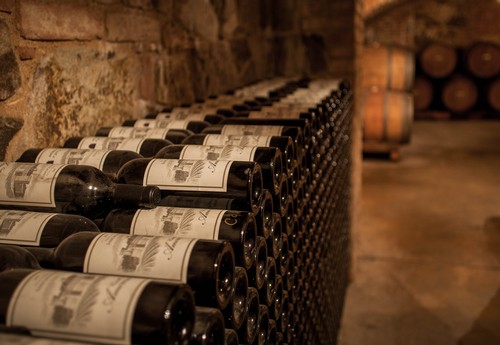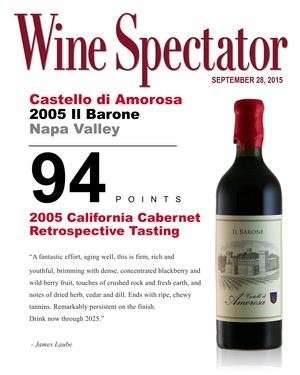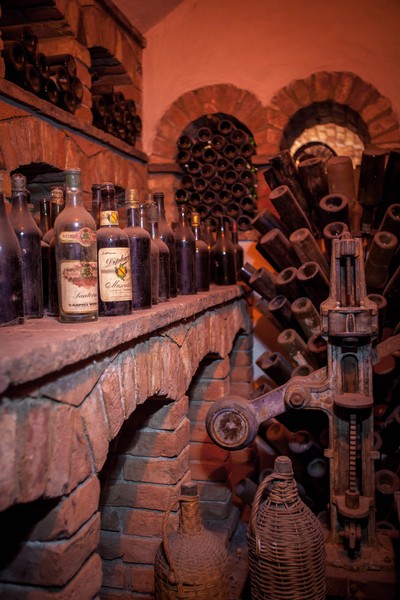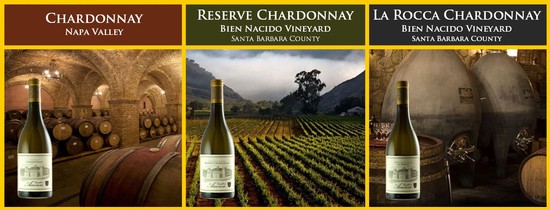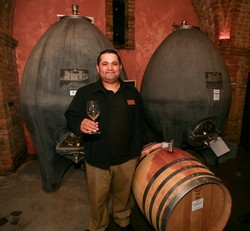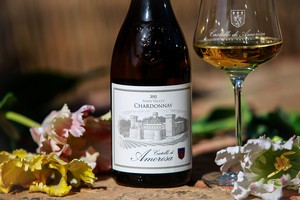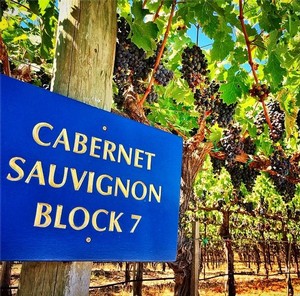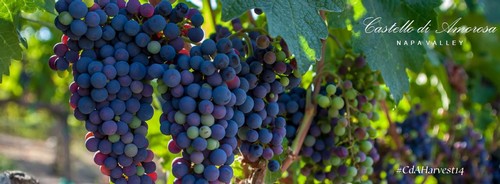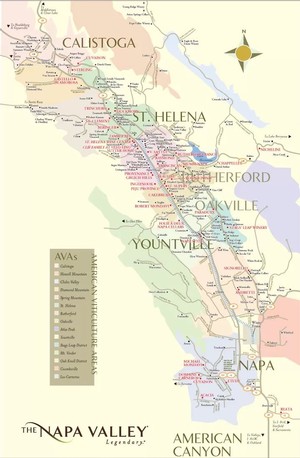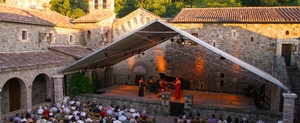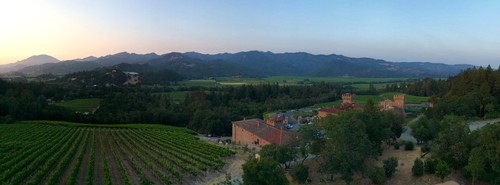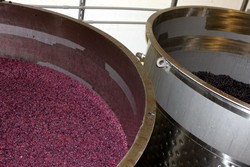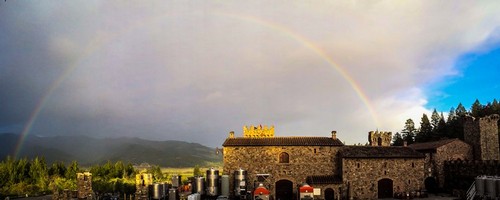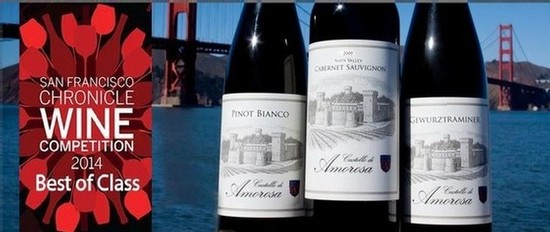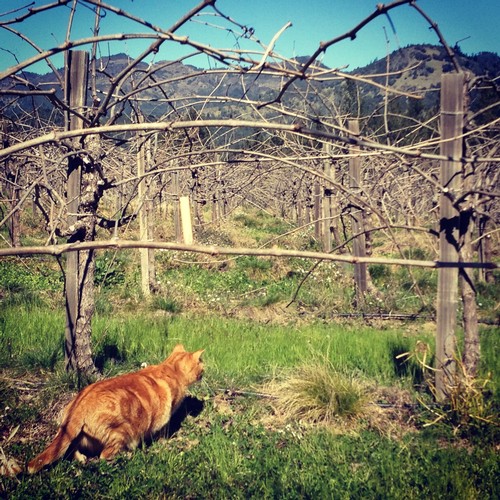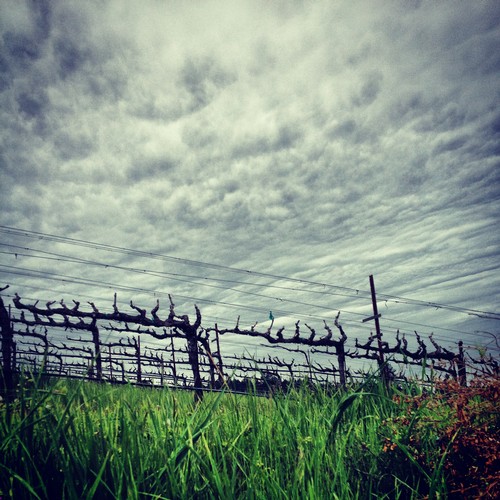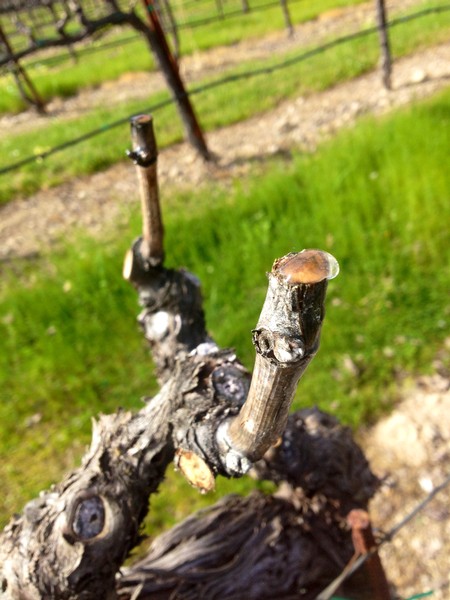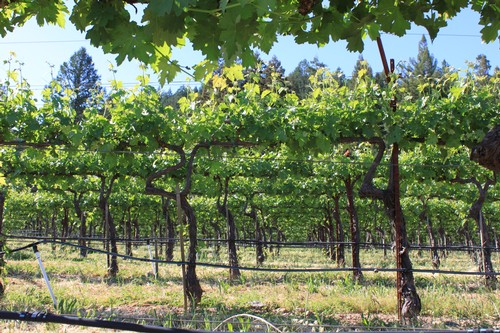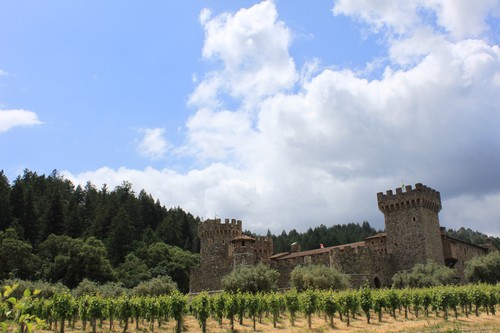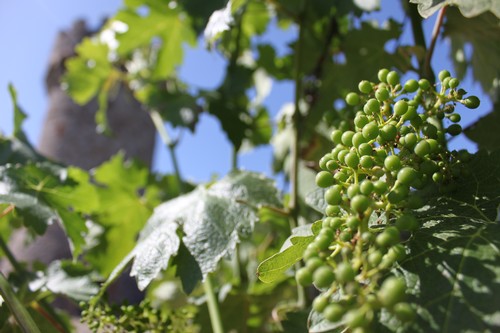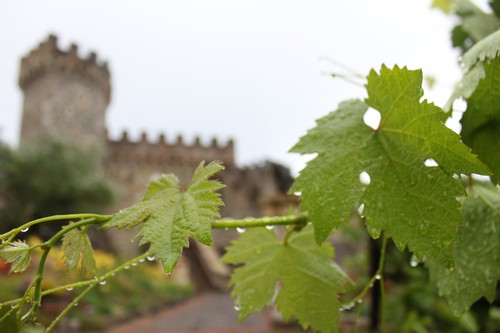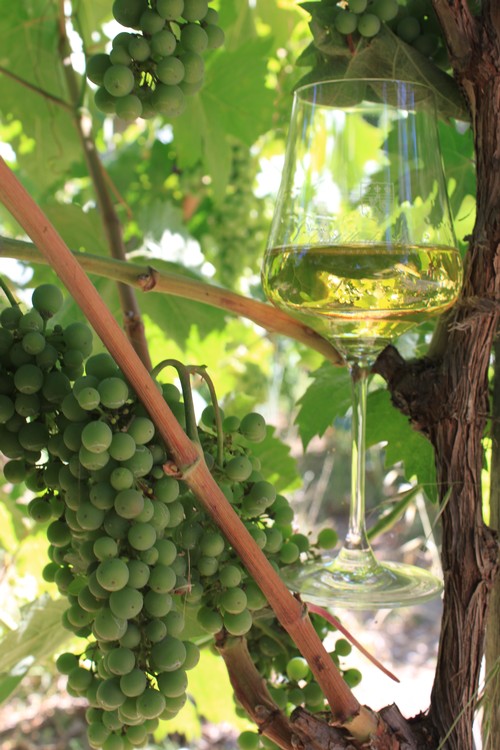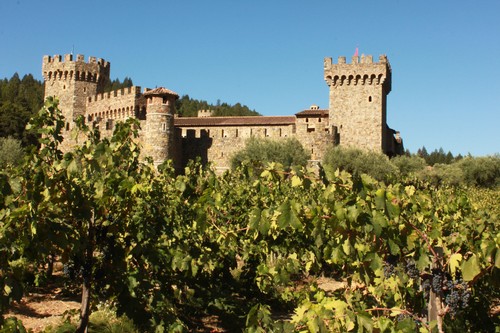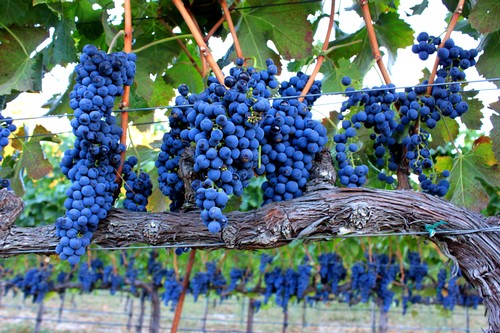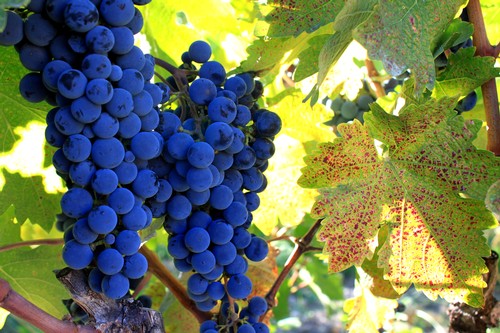Aging Gracefully
If you have ever taken a guided tour of the Castello, you will have walked past our Library Rooms, filled with the Castello’s older vintages resting quietly in their cool brick shelves in small, frescoed rooms behind hand-forged wrought iron gates. One of these rooms even houses wines from Dario’s great grandfather’s original winery in San Francisco, dating back over a century. These dimly lit rooms raise numerous questions from inquisitive guests: what is the best way to age wine? How should you store your bottles? How long should you age them? Are those 100 year old bottles still drinkable? All great questions! Now for some answers…
♦ Storing Your Wines
Whether you’re planning on enjoying the bottles you brought back from your trip to the Castello next week, next year, or next decade, there are a few simple steps you can take to ensure that your wine will be perfectly ready to drink when you pop that cork:
- Store cork sealed bottles on their side. This will help to ensure that the cork stays moist, preventing it from drying out and letting oxygen into the bottle.
- Store screw cap bottles upright. Since there is no cork, there is no need to store these bottles on their sides.
- Keep your wines out of direct sunlight. The back seat of your car or your kitchen window are definitely not ideal places to keep your favorite bottle of Castello wine. Light can be damaging to wines, altering their delicate chemical balance and potentially even heating up your wine. This is why the lights you see in our Library Rooms are dim and red, and also why most ageable wines such as Cabernet Sauvignon come in deep green bottles; the color of the bottle helps to prevent light rays from penetrating through the glass.
- Store your wines at a cooler temperature. Hot wine = cooked wine, which can be a sad sight to see (and a terrible thing to taste). You’ll notice heat damage to your bottles if the cork appears to be popping up from the bottle. Most wines are best kept around 55° Fahrenheit (13° Celsius). Keeping them cooler also helps to slow the aging process. Storing your bottles in a slightly humid environment (60-70% on average) is also helpful for preventing the cork from drying out at the end not in contact with the wine. If you don’t have a wine fridge or cellar, keeping them in a cool place out of direct sunlight, like a closet or a wine rack in the coolest part of your house, should do the trick just fine.
♦ Aging Your Wines
Are a Cabernet Sauvignon and a Pinot Grigio capable of aging the same amount of time? Definitely not. There are certain characteristics of specific grape varietals, as well as how the wines are aged before bottling, that determines a wine’s ageability. The vast majority of wines available in the market today are meant for consumption sooner rather than later. Some, however, absolutely benefit from some quiet time in the cellars.
- Bold red wines like our Il Barone Reserve Cabernet Sauvignon and La Castellana Super Tuscan blend are capable of long-term aging, typically up to 15 years from the vintage date on the bottle. This is because these wines have the structure capable of aging due to the tannins imparted from thick skins of the Cabernet grapes as well as the new French oak barrels they’re aged in. As the wine sits in the bottle, these tannin molecules are linking together and falling to the bottom of the bottle as sediment; which is often why so many younger Cabernets tend to pack a bigger “punch” than older vintages (and also why so many older red wines are decanted to remove the sediment). While these wines are fantastic to drink now, they can be even better after laying down for several years, as the structure of the wine smooths out and the tannins are allowed to integrate further.
- Our 2005 Il Barone was recently awarded 94 Points from Wine Spectator Magazine in a ten year retrospective tasting led by wine critic James Laube, which only helps to prove that those bottles of Castello Cabernet in your cellar are getting even more spectacular with age!
- Light-bodied white and sweet wines like our Pinot Grigio and La Fantasia are meant for drinking within the first five years from its vintage date. These wines are prized for their bright and crisp qualities; as they age these characteristics tend to fade. So if you’ve been hanging onto that bottle of 2006 La Fantasia, it might be time to pop that bottle before it’s too late!
- If you’re ever curious about how long to age your favorite bottle of Castello wine, check out our Ageability and Cellaring Chart, which shows the proper time, temperature, and storing positions for our premium and reserve wines.
So whether you’re building your own Tuscan-inspired brick and frescoed underground cellar, or are simply looking to keep your prized Castello wines from cooking in the living room of your apartment, there are plenty of ways to ensure that you’ll be enjoying your favorite bottle at the best time, temperature, and place! Just be sure to drink them before they turn 100!
Chardonnay - The Golden Queen of California
It has often been said that if Cabernet Sauvignon is king here in Napa Valley, then Chardonnay is queen. Chardonnay has reigned supreme among white wine grapes in California since the Judgment of Paris in 1976, when Chateau Montelena’s 1973 Chardonnay trumped the French competition in a blind tasting and helped to put Napa Valley on the map of world-renowned winegrowing regions. Today, there are over 100,000 acres of Chardonnay vineyards planted throughout California, and the varietal remains one of the top white wines consumed by Americans each year.
One of the reasons for Chardonnay’s popularity is the wide variety of styles it can be crafted in, based on where the grapes came from and how the wine was aged. While the majority of Chardonnays are aged in oak barrels, unoaked Chardonnays are rapidly increasing in popularity due to their brighter, fruitier notes, and both aging styles offer a wide range of complexity in the finished wines.
Chardonnay at the Castello
Here at the Castello, we produce two Chardonnays every year from two select cool climate vineyards in California. Our Napa Valley Chardonnay fruit comes from own estate vineyard in the Los Carneros AVA (American Viticultural Area) in the southern end of the Napa Valley, which is meticulously tended to by our Vineyard Manager, David Bejar, who has worked with Dario Sattui and our winemaking team for the past 17 years. Our Bien Nacido Vineyard Chardonnay comes from the iconic family owned vineyard in the Santa Maria Valley in Santa Barbara County, along the Central California Coast. In using these two cool climate vineyards to produce our Chardonnays, we hope to showcase the unique terroir of each region while utilizing both traditional and innovative winemaking techniques.
Our Bien Nacido Vineyard Reserve Chardonnay
All of our Chardonnay is harvested at night in order for the fruit to arrive at the Castello cold, which preserves the its delicate aromatics and natural acidity. Once the fruit gets to the winery, the whole grape clusters are placed into our two pneumatic, or “bladder” presses, which gently presses the juice from the skins and seeds. The juice is then pumped into Burgundian French oak barrels, where it ages for 8-10 months. We use 50% new and 50% second use French oak barrels on our oak-aged Chardonnays, which provides a balance between showcasing the terroir of the vineyard, acidity and fruit characteristics of the varietal, and the subtle notes of toast and spices that come from each individual barrel.
Two of our clear-headed oak barrels, which show the wine aging on the lees
After the wine has undergone primary fermentation, which converts the sugars in the juice into alcohol, our winemaking team then selects a specific number of barrels to undergo malolactic, or secondary fermentation. Here, the malic acid in the juice is converted into lactic acid, which gives Chardonnay its signature creamy mouthfeel (think “lactose” like milk). Roughly 40-60% of our Chardonnay barrels undergo malolactic fermentation, depending on the characteristics of the vintage and the acidity levels of each blend.
La Rocca Chardonnay – A new twist on a classic wine
If you have visited the Castello on a guided tour, you may have noticed our concrete fermentation eggs in the Grand Barrel Room, our 12,000 sq ft cross vaulted room three levels underground. We have been using these concrete eggs for the past several years to craft select single vineyard white wines like our Ferrington Vineyard Dry Gewurztraminer and Tyla’s Point Pinot Bianco, and beginning with the 2013 vintage we are also fermenting and aging a select amount of our Bien Nacido Vineyard Chardonnay in one of these eggs. We have named this unique, limited-release wine “La Rocca,” which means “The Fortress” in Italian. The egg shape allows for a natural suspension of the lees (sediment) compared to aging in traditional stainless steel tanks, without imparting any flavors or aromas found in oak barrel aging, and the higher acidity and tropical fruit characteristics of the Bien Nacido Vineyard Chardonnay made this fruit a perfect choice for aging in these unique vessels.
Cellar Master JoseMaria Delgado sampling our Napa Valley and La Rocca Chardonnays at The Grand Barrel Party
We are excited to make two Chardonnays from this historic vineyard in both French oak and concrete, as these two differing styles help to show the versatility of the varietal as well as the vineyard. Our La Rocca Chardonnay from Bien Nacido Vineyard is released each year to several of our shipping clubs, and we look forward to showing off the versatility of this beautiful Burgundian grape with our trio of California Chardonnays with each vintage!
Verasion in the Vineyards - Harvest is Coming!
Harvest season is fast approaching here in the Napa Valley, and we’re seeing beautiful changes in the vineyards surrounding the Castello as the grapes ripen on the vine. This is the time of year when verasion occurs, or the “onset of ripening” of the berries.
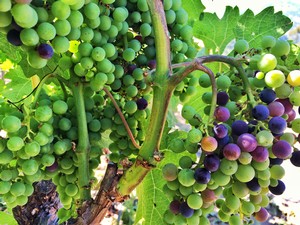
The green berries begin changing to different shades of purple to a dark blue-violet color as they take on the characteristics of their specific varietal. This typically begins in the late summer season, and this year we saw verasion beginning in our estate vineyards around the beginning of July.
It’s a beautiful time to visit Napa Valley and see the changing colors as the summer season turns to fall. We are looking forward to Harvest 2014!
Planning your summer visit to Napa Valley
Summer is a beautiful time to visit Napa Valley. Well let’s face it, with our mild, Mediterranean climate pretty much any time of year is great to visit, but soaking up the sunshine while surrounded by vibrant green vineyards, rolling hills, and a glass of wine in hand is a fantastic way to spend an afternoon in the warm summer months. Here are a few ways to maximize your fun in the Napa Valley sun in the summertime:
♦ Pick 1-2 "can't miss" wineries, and fill in the gaps with others as your day progresses. Keep in mind that each winery will pour you roughly the equivalent of one glass (5 oz) of wine, so it’s good to limit yourself to 3-4 wineries per day. Trying to plan tastings at more than 3 wineries for one day can leave you feeling rushed, and wine country is all about relaxing. You’re on vacation, after all!
♦ Visit larger/ more popular wineries before noon. Larger wineries can draw crowds of thirsty travelers, especially on the weekends, and these crowds tend to get larger later on in the afternoon. Visiting these wineries before noon allows you to have a more relaxed experience to enjoy your tasting and explore the grounds at a leisurely pace.
♦ Plan on spending 1-2 hours at each winery. This goes along with the “choose 3-4 max” rule of wineries per day (especially if you’re planning for winery tours). Most wineries in Napa Valley open around 9:30am and close around 6:00pm in the summer, so figuring out how early you want your day to start/ where you’re travelling to can be a big factor of how much time you have to actually taste. Pace out your day and take the time to enjoy each winery you visit without feeling you need to jump to the next.
♦ Look for specialty tours. Many wineries throughout the valley offer experiences beyond the standard tasting, and these are a great option to take advantage of, especially with the larger wineries as it allows for a less crowded and more personal experience. Cheese pairings, food and wine pairings, and guided tours are a fantastic way to learn more about what goes into each winery's philosophy and connect you even more with the delicious vintages being poured for you!
♦ Have a designated driver. If nobody wants to take the keys, it might be a good idea to look into hiring a driver for the day. Napa Valley has many car and limo services that cater to the thirsty traveler (and even a Wine Train!), and if you’re staying in Calistoga, their shuttle is a great option for getting around the northern end of the Valley!
♦ Bring a water bottle/ snacks. Hydration is important! You’ll want to drink roughly one 8 oz glass of water for each tasting if you’re looking to avoid feeling too groggy by the end of your day, and it’s never a good idea to taste on an empty stomach! Keep in mind that most Napa Valley wineries cannot offer picnic facilities per county ordinance, so plan on snacking in the car or finding a park if you wanted to have a full picnic (our sister winery V. Sattui is one of the few wineries to offer picnic facilities, located just south of St. Helena).
♦ Start your day at the winery farthest away from your hotel/ dinner location and work your way back towards it. This helps to insure that you’re not stuck with a long drive when you’re all tired out from a full day of exploring the valley.
♦ Wear comfortable shoes (LADIES I’m talking to you here). Girls, I know you love those three inch heels, but I promise you will not be loving them after a day of walking on uneven surfaces/ in vineyards/ touring wineries/ standing at tasting bars. You don’t want to be the one drinking just to get to that point where you can’t feel your feet anymore.
♦ Bring a light jacket. Daytime temps in Napa Valley tend to range from mid-70s all the way to low 100s, but it does drop down to the 50s in the evenings here, which can be a bit of a shock if you’re out in shorts and flip flops. Also keep in mind that most caves/ tasting rooms are around 50°-60°F (10°-15°C) to help keep the wines cool for aging (and pouring). Wine only helps to warm you up so much!

♦ Make reservations whenever possible. Whether for restaurants or winery tours, it never hurts to call ahead (especially if you are a big group!!). Summer is the busiest time of year in Napa Valley, and many winery tours/ restaurants book up quickly!
♦ Expect some traffic. I’m not talking full-blown rush hour madness, but don’t expect to be cruising down the highway at 80mph between wineries in the middle of the day. There are only two main roads to get through the valley (Hwy 29 on the west and Silverado Trail on the east), and since both are mostly 2 lane roads, you can imagine how easy it would be for either to back up quickly due to congestion, construction, accidents, or that person who slammed on their brakes because they almost missed their winery (on that note: please don’t be that person. Make a U-turn!!). If your winery or restaurant reservation is at 2:00, plan to be there at least 15 minutes early to check in. You won’t want to miss a thing!
♦ See if any events are happening while you're here. Wineries throughout the Valley love to host special events year-round, and it's always a great idea to check out what's going on while you're visiting! From concerts in the park to winemaker dinners or themed parties like the Castello's Midsummer Medieval Festival or Hot Havana Nights, summer evenings are packed full of great opportunities to sip, swirl, & savor after the tasting rooms close!
And most importantly…
♦ Remember: it’s a wine TASTING, not wine DRINKING. Pace yourself! Relax, and enjoy your visit to this world-famous wine growing region. With beautiful wines and incredible views all around you, you’ll be mapping out your next visit before you leave!

So grab that Napa Valley map and get to planning! With over 400 wineries and so many fantastic restaurants and things to do from Carneros to Calistoga, you have some important decisions to make!
Adventure (and wine) is out there!
Castello di Amorosa wins big at this year's San Francisco International Wine Competition
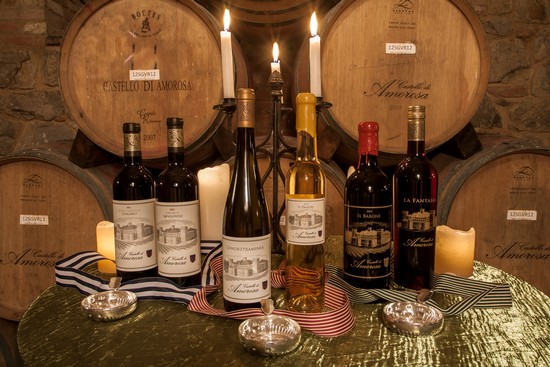
Last month, a panel of 58 judges gathered at the Nikko Hotel in downtown San Francisco to taste their way through a record 4,570 wines from 26 states and 31 countries at the San Francisco International Wine Competition. This was the first year we have entered our wines into this prestigious competition (at which our Director of Winemaking, Brooks Painter, won Winemaker of the Year for our sister winery, V. Sattui last year), and our wines were very well received by the judges. Overall, we received a Best of Class, Double Gold, 4 Gold, 7 Silver, and 3 Bronze medals!
2013 Dry Gewurztraminer - BEST OF CLASS
2010 Il Passito Late Harvest Semillon/ Sauvignon Blanc - DOUBLE GOLD MEDAL
2010 Il Barone Reserve Cabernet Sauvignon - GOLD MEDAL
2010 Napa Valley Sangiovese - GOLD MEDAL
2011 Zingaro - GOLD MEDAL
2013 La Fantasia - GOLD MEDAL
Cheers to our fantastic winemaking team!
Worlds of Wine - Old World vs New World Winemaking
Napa Valley is world famous for its premium-quality wines, placing it alongside other winegrowing regions such as Bordeaux and Burgundy in France, Chianti in Italy, Rioja in Spain, and Barossa Valley in Australia. While these regions may all grow similar varietals of grapes like Cabernet Sauvignon or Chardonnay, the overall style and even legal requirements of winemaking can produce very different results in the bottle. These differences are often referred to as “Old World” vs “New World” styles of making wine. But what do these differences really mean?
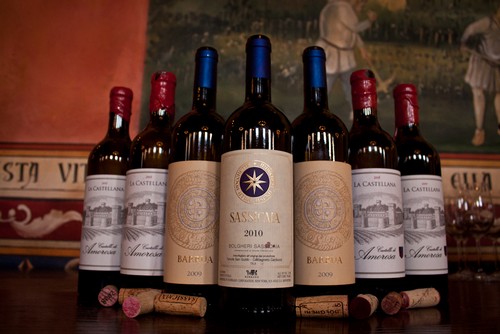
The Castello's La Castellana Super Tuscan alongside the Super Tuscans of Barrua and Sassicaia from Italy
"Old World"
The “Old World” of wine refers to the original winegrowing regions, including Italy, France, Spain, and other nations whose viticultural practices date back hundreds of years. Stylistically, “old world” wines are typically made using traditional methods and techniques, which are often controlled by strict laws that determine what goes in to each wine in order to earn the name on its bottle. For instance, Italian laws in the Chianti region require that every bottle of wine labeled “Chianti” contain at least 80% of the Sangiovese grape.
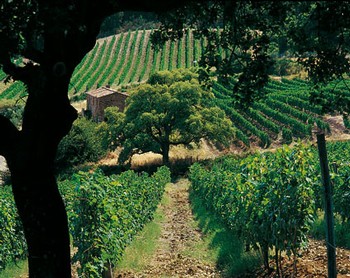
The vineyards of Tenuto San Guido in Bulgheri, Tuscany
You might also notice more “Old World” wines tend to consist of blends, or list only the name of the region in which it was produced rather than a specific varietal. For instance, a “white Burgundy” from France would most likely consist primarily of Chardonnay grapes, or a red “Bordeaux blend” would contain at least two of the five varietals traditionally grown there (Cabernet Sauvignon, Merlot, Cabernet Franc, Petit Verdot, and Malbec). Blending varietals allows winemakers to produce a balanced, often softer style wine, and tends to focus on the “terroir,” or region the grapes were grown, rather than particular types of grapes. This tends to lead to these wines displaying more earthy or mineral characteristics in the glass. “Old World” wines also tend to be lower in alcohol, which allows them to be much easier to pair with food.
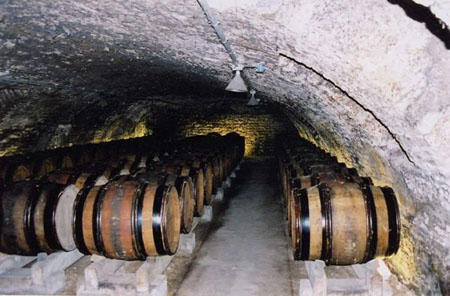
Patriarch Cellars, France
"New World"
Since “Old World” typically means “Europe,” think of the “New World” of wine as basically everywhere else. “New World” regions such as California, Australia, and Argentina have adopted the techniques and varietals of the “Old World” and expanded upon them with new winemaking technologies, often without the strict legal requirements in place in Europe. Wines produced in this style are often described as more “fruit-forward” and oakey, and tend to have a higher alcohol content than Old World wines. Think of your traditional “Big Napa Cab” found so often out here in the Valley, with its rich fruit and bold tannins that make you instantly crave the largest ribeye steak you can find.
The Castello overlooks the northern end of Napa Valley from the foothills of the Diamond Mountain District
Castello di Amorosa: where “Old” meets “New”
Here at the Castello, we focus on “Italian-style” wines, meaning we like to use Italian varietals such as Moscato, Pinot Bianco, Pinot Grigio, Sangiovese, and Barbera. However, because our grapes are grown in Napa Valley and other regions of California, they do have a distinctly “New World” flavor profile, especially for Cabernet Sauvignon, Merlot, Zinfandel and Chardonnay where the local “Terroir” is evident in the glass.
We try to take an “Old World” approach to our winemaking, including traditional winemaking methods such as hand-picking grapes, using gentler press and fermentation techniques such as bladder presses and the “punch down” method for maceration, and aging many of our wines in French Oak barrels in our caves.
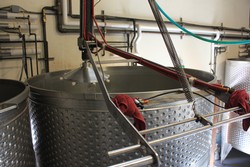
Open top fermentation tanks, to allow the "punch down" of the grape skins & seeds during maceration
Our blends like Il Brigante, and La Castellana “Super Tuscan” have a balanced approach between the varietals, creating a softer, more velvety wine. Keeping our alcohol levels more moderate for our red wines helps to create a more food-friendly style that won’t overwhelm your palate at the lunch or dinner table. We hope to bring a bit of the Old World to the New here in world-famous Napa Valley, and we raise a glass to all of the wonderful wines made here and all over the world that bring new inspiration with every vintage!

Cheers to the best of both worlds!
Bringing Wine Country Home: How to Throw a Wine Tasting Party
A great perk of living/ working in wine country is the opportunity to be exposed to a wide variety of wines and winemaking styles. One of the obvious ways to expand one’s palate in this area is going out and exploring the myriad of tasting rooms and wineries available (and with over 375 in Sonoma County and 400+ in Napa Valley, there are many important decisions to make!). Basically, we in the wine world lead a rough life of roaming around beautiful rolling hillsides and valleys covered in leafy green and gold beauty searching for whatever our taste buds desire.
Just another day at the office...
Like I said, life’s hard sometimes.
But what about experiencing wine after hours? Or what if you don’t have the ability to drive 20 mins to an hour to get to the nearest winery? Well there are plenty of opportunities to explore new vintages and varieties from the comfort of your own home. Why not try hosting a wine tasting party?
A group of us at the Castello get together on a regular basis for wine tastings, and it always ends up to be an enlightening, delicious, and fun way to try new wines and hear impressions from everyone. We’ve had evenings dedicated to a specific varietal (such as Pinot Noir), winemaking styles (Old World vs New) and wine regions around the globe. Our most recent tasting focused on the wines of Spain. We sampled Riojas, Priorats, and Tempranillos with Spanish cheeses and Tortilla de Patata, a classic Spanish egg and potato appetizer made by our very own resident Spaniard, Maria!
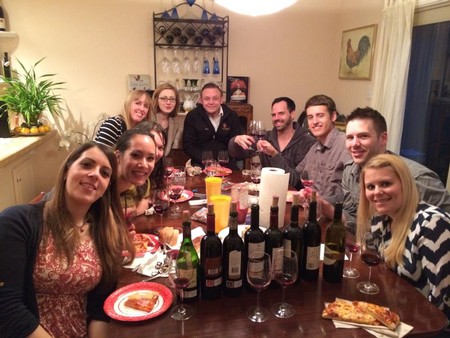
Spanish wine tasting night with the Castello crew (and friends!)
Throwing a wine tasting party can be fun and easy, and is a great way to connect with friends over a few bottles of delicious vino! Here are a few tips for planning your own wine tasting night:
What you need:
♦ Wines (obviously) – Make sure to have enough wines for your party to taste! It’s generally a good idea to keep these get-togethers between 6-12 people so everyone has a chance to sit around the table and share their thoughts and stories about the wines being poured, and it’s a good plan to allot about a half bottle’s worth of wine per person at the tasting, though having an extra bottle or two on hand never hurts “just in case”! Keep the pours around 2 ounces for each wine, especially if you have a wider selection to taste through.
♦ Glasses – Always make sure to have enough glasses for all guests present. It’s usually nice to have at least 2 glasses per guest, especially if you want to evaluate your wines side-by-side. It’s fine to reuse the glass for multiple wines, as long as you’re not going from a red to a white or sweet (you don’t want to make your own “rose”)
♦ Dump Bucket – Have a vase or pitcher off to the side for people to dump any wine they don’t want to finish (remember, the more wines you consume, the less you’ll be able to taste!)
♦ Water – Place a water pitcher on the table with glasses for guests to sip from between tastings. Sparkling water is even more helpful in warding off the dreaded "palate fatigue"
♦ Snacks – Small bites make a delicious centerpiece at the table. Try to find foods that pair with the wines you’ll be trying; cheeses and charcuteries with a fresh baguette are always a good idea, and you can even ask your guests to bring an appetizer they think would complement the wines.
♦ Wine charms/ glass markers – These are helpful to keep track of which wine is in which glass. If you’re on the third round of tastings and trying a California Cabernet next to a French Bordeaux, it definitely doesn’t hurt to have a little reminder to keep you focused on what’s in front of you. If you don’t have wine charms, dry erase markers or even stickers work well (as long as they peel off easily)
♦ Notepads/ pens – These are especially useful for guests who want to remember which wines were tasted and which were their favorites. Great to hang on to for the next time you’re trying to remember a delicious wine you had to pair with dinner!
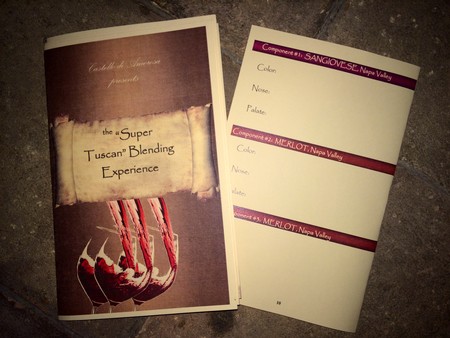
You can even segment notes to help guide your guests through their tasting with categories like Color, Nose, Taste, and Finish
Things to avoid:
♦ Perfume/ cologne – Remind your guests to refrain from wearing any strong scents, as this can detract from the overall tasting experience (as nice as your Chanel No 5 may smell, nobody wants to be drinking it)
♦ Scented candles/ flowers – Same reasons as above (nobody wants to be picking up "essence of Pumpkin Spice" in their Pinot Bianco)
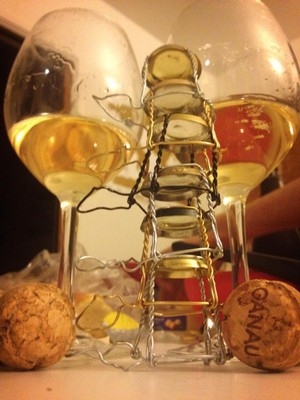
Who needs candles when you can make your own centerpiece from corks and Champagne cages?
There are plenty of great themes you can have with a tasting party. Here are a few to start you off with:
♦ Varietal tasting – Pick a grape and see how the results differ based on where it’s produced and who is making it. Examples: Try Pinot Noirs from Burgundy, Sonoma, Carneros, and Oregon to see how terroir affects the outcome
♦ Old World vs New World – Choose wines from a specific “Old World” region (think Europe) and compare them with their “New World” counterparts. Examples: Italian varietals (Sangiovese, Barbera, Pinot Grigio) vs. their California counterparts
♦ Vintages – Pick a specific wine from your favorite winery and see how that wine changes with each year. Examples: A vertical tasting of Castello di Amorosa Cabernet Sauvignon from 2008 – 2010
♦ Blind Tasting – Break out the brown paper bags and test your senses! See if you can spot the difference between a Merlot and Cabernet Sauvignon, or a Riesling vs Moscato. The sky’s the limit!
And finally, the most important part of a wine tasting party: Have fun!! Whichever wines you choose, you'll be sipping, swirling, and savoring a great evening with good friends!
Salute!

So many glasses, so little time…
Castello wines win big at SF Chronicle Wine Competition!
Results are in from the 2014 San Francisco Chronicle Wine Competition, and once again Castello di Amorosa’s wines shone brightly among the competition!
This year’s competition included a record number of 5,825 wines entered from over 1,500 wineries from over 25 states, making this the largest competition of wines in America.
We are proud to announce that this year three of our wines received the Best of Class distinction, and we received one Double Gold Medal, six Gold Medals, four Silver Medals, and one Bronze Medal! Here are our winning wines:
2012 Pinot Bianco – BEST OF CLASS
2012 Dry Gewurztraminer – BEST OF CLASS
2009 Napa Valley Cabernet Sauvignon – BEST OF CLASS
2010 Napa Valley Merlot – DOUBLE GOLD MEDAL
2010 “Il Barone” Reserve Cabernet Sauvignon – GOLD MEDAL
2009 “La Castellana” Reserve Super Tuscan – GOLD MEDAL
2012 Bien Nacido Vineyards Reserve Chardonnay – GOLD MEDAL
2012 Napa Valley Chardonnay – GOLD MEDAL
2011 “Zingaro” Zinfandel – GOLD MEDAL
2010 Napa Valley Sangiovese – GOLD MEDAL
2012 Anderson Valley Reserve Pinot Noir – SILVER MEDAL
2011 King Ridge Vineyard Pinot Noir – SILVER MEDAL
2012 Los Carneros Pinot Noir – SILVER MEDAL
2009 “Il Brigante” Red Blend – SILVER MEDAL
2012 Late Harvest Gewurztraminer – BRONZE MEDAL
You can attend the public tasting event taking place in San Francisco at Fort Mason on Saturday, February 15th, where over 800 wineries will be pouring from 1:30 – 5:00pm. Be sure to find us among the crowd to taste our award winners!
You can check out ticket information and view the full list of winners at www.winejudging.com
A Look Back on the 2013 Vintage
2013 has been an incredible year for the vineyards of the Napa Valley, with the Napa Valley Vintners calling this year's growing season "early, even, and excellent." The 31 acres we have planted around the Castello with Sangiovese, Merlot, Primitivo, and Cabernet Sauvignon developed beautifully over the course of the year, and we loved tracking the beauty each season brought to the vines. Now that another record year in the valley is coming to a close and the vineyards again lay dormant, we're looking back on the fruits of this year's labors. Here are a few of our favorite vinyeard photos from this past year:
January
Sir Lancelot enjoyed playing beneath the dormant Primitivo vines in front of the Castello
February
The Cabernet Sauvignon vineyards above the Castello, pruned back to allow healthy new buds to begin forming
March
The vines began "weeping" in preparation for the arrival of new buds
April
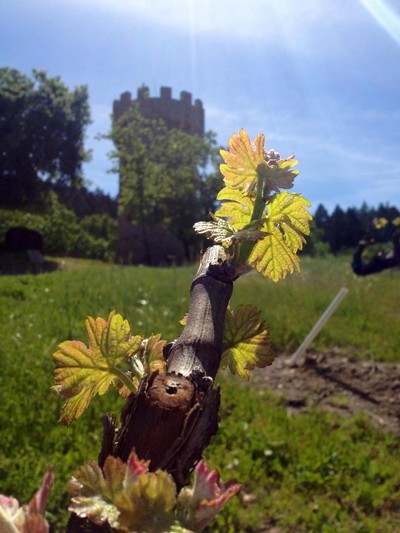
Bud break arrived at the Castello in early April, and the vineyards quickly brightened with springtime colors
May
The warm, dry spring we had throughout the valley allowed for earlier bud break and perfect conditions for flowering
June
June saw the arrival of berries on the vines.
The vines saw a bit of rain in a summer shower
July
The warm summer months allowed for an even ripening of the berries. Here a cool glass of Charonnday rests among the Primitivo vines.
August
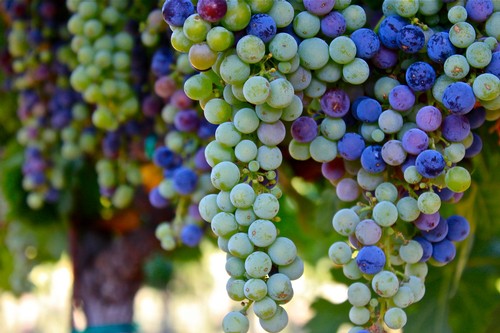
The end of August saw verasion in the vineyards, as the berries began to ripen and change color.
September
Primitivo vines and berries in front of the Castello
The Merlot vineyards almost ready for harvest!
October
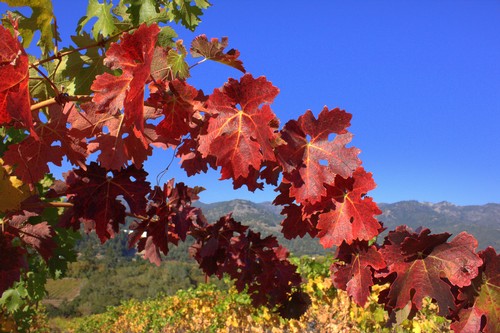
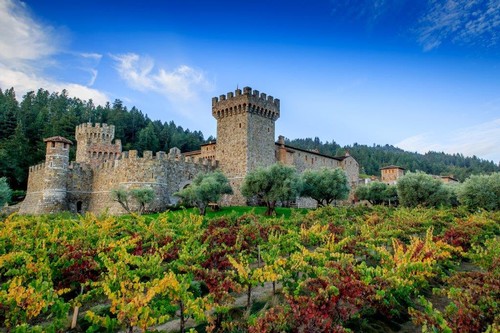
November
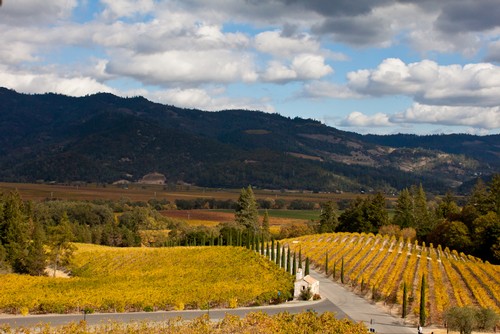
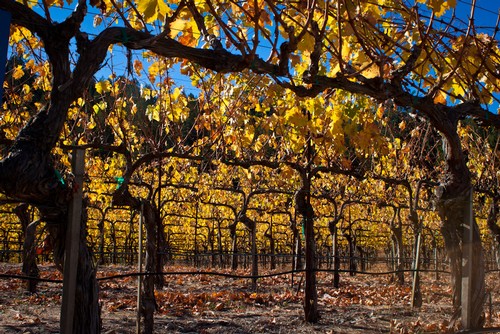
December
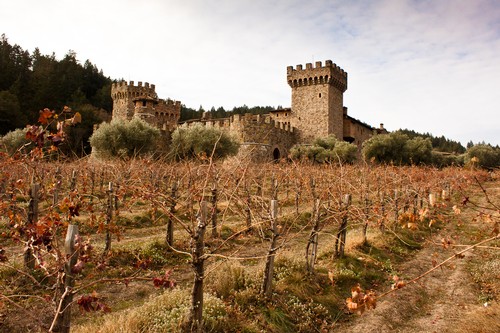
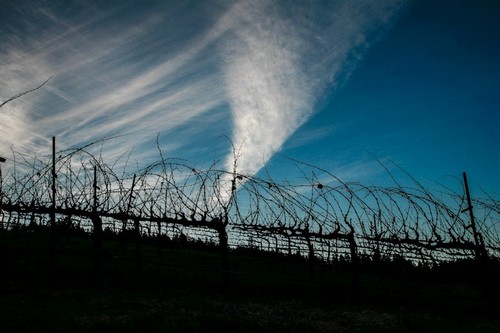
Cheers to the end of another fantastic year in the Napa Valley! We're looking forward to 2014!
Create the Castle: A Photo Contest on Instagram
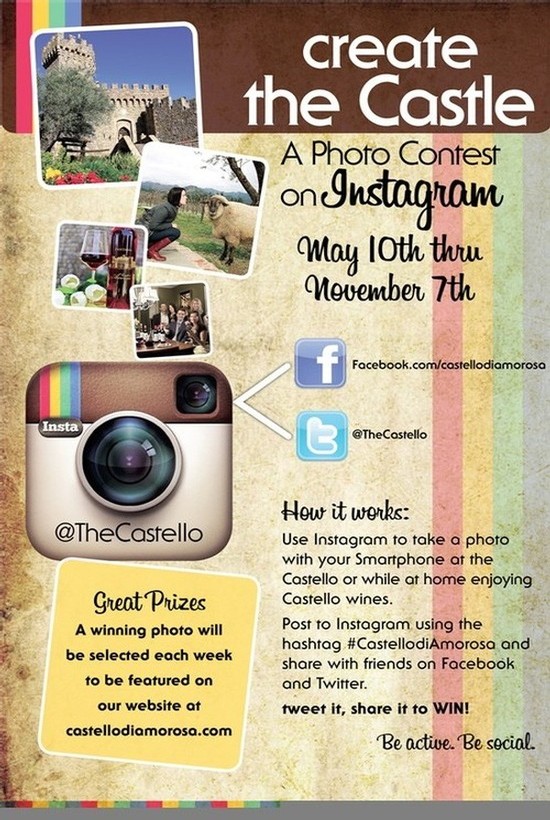
WEEK TWENTY-SIX WINNER
We've reached our final week of our "Create the Castle" Instagram contest, and we are thrilled with how many fantastic photos we have received from all of our fans! Thank you for sharing your wonderful photos of your times here at the Castello and enjoying our wines with your friends and family at home. Keep on sharing your great shots with us on Facebook, Instagram, and Twitter by tagging us with #castellodiamorosa; we love sharing them with our fans on social media!
Our Week 26 winner is @jaymessong, who captured the beautiful fall colors around the Castello from our South Tower. Congratulations, and thank you for visiting and sharing such a great photo with us!
Check out our fantastic runners up from this past week! Thank you again for sharing your great photos with us, and cheers from all of us at the Castello! #castellodiamorosa
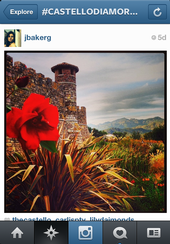
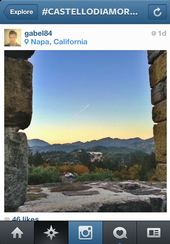
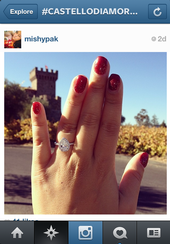

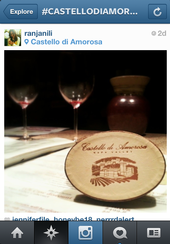
WEEK TWENTY-FIVE WINNER
We're in the home stretch of our "Create the Castle" Instagram contest! We've received over 8,000 photos tagged with #castellodiamorosa, and we've been loving the creative ways you show how much you love the Castello and our wines! This week's winning photo is from @jed_pilgrim128, who captured the gorgeous clouds above the Castello this past week. Congratulations, and thank you for sharing such a beautiful photo!
We may just have one week left in the contest, but we still can't get enough of your fantsatic photos! Thank you for tagging us at #castellodiamorosa and for sharing your photos on Instagram, Facebook, and Twitter! Here are a few more favorites from this past week!

